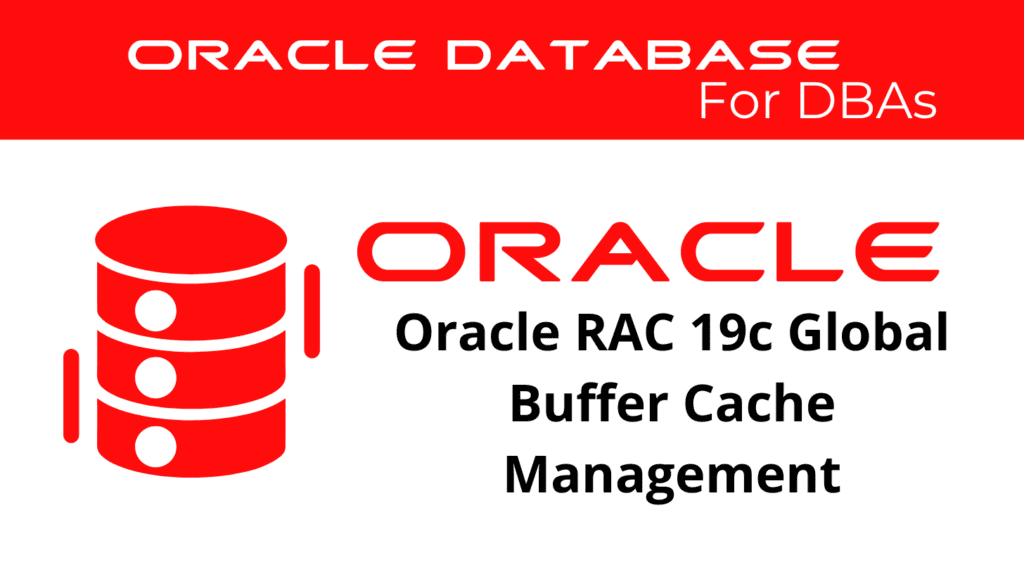
In this article, we will delve into Oracle RAC 19c and how global buffer cache management is effectively handled. Buffercache management and cache performance are crucial for maintaining data consistency and performance in a clustered environment like Oracle RAC. This tutorial will provide a comprehensive understanding of these concepts within Oracle RAC 19c.
Understanding Buffer Cache Management
Buffercache management, or cache handling, is a critical aspect of Oracle RAC 19c. Efficiently managing the buffercache ensures that frequently accessed data is readily available, reducing disk I/O and improving performance. This involves managing memory allocation and optimizing cache usage across all nodes in the RAC environment.
Types of Buffer Caches: Oracle RAC 19c manages several types of buffer caches, including the database buffercache, the keep buffercache, and the recycle buffercache. Each type serves a specific purpose in maintaining database performance and efficiency.
Example1: Viewing Buffer Cache Statistics:
SELECT * FROM v$bh;
This query retrieves statistics about buffercache usage across the RAC environment.
Tools for Managing Buffer Cache: Oracle RAC provides several tools for managing buffercache, such as V$ views and Oracle Enterprise Manager. These tools help administrators monitor and optimize cache-related activities, ensuring smooth database operations.
Preparing for Buffer Cache Management
Before managing buffer caches, it is essential to configure the necessary settings and understand the environment.
1. Configuring Init Parameters: Ensure that the initialization parameters related to buffer cache are properly configured.
ALTER SYSTEM SET db_cache_size = 2G SCOPE = BOTH;
2. Monitoring Buffer Cache Usage: Regularly monitor buffercache usage to identify potential bottlenecks and optimize performance.
Example2: Monitoring Buffer Cache Usage:
SELECT name, value FROM v$sysstat WHERE name LIKE 'physical reads%';
This query provides details about physical reads, which can indicate buffer cache performance issues.
📢 You might also like: Oracle RAC 19c Affinity to Reduce Global Resource Contention (Category: RAC and GRID)
Cache Performance Techniques
Cache performance, also known as cache control, plays a vital role in Oracle RAC 19c. This process involves optimizing the allocation and usage of the buffercache to ensure high performance and efficiency. Oracle RAC uses sophisticated algorithms to manage cache performance effectively.
Optimizing Cache Performance: Oracle RAC 19c provides several techniques to optimize cache performance, such as adjusting cache sizes and using cache advisory tools. These techniques help ensure that the buffer cache is used efficiently and that frequently accessed data is readily available.
Example3: Using Cache Advisory:
SELECT size_for_estimate, buffers_for_estimate, estd_physical_read_factor
FROM v$db_cache_advice
WHERE name = 'DEFAULT';
This query retrieves cache advisory information to help optimize buffer cache size.
Managing Cache Efficiency: Effective cache control involves monitoring cache hit ratios, adjusting cache sizes, and using partitioning strategies. Tools like Oracle Enterprise Manager and V$ views aid in this process.
Example1: Checking Cache Hit Ratio:
SELECT (1 - (physical_reads / (db_block_gets + consistent_gets))) * 100 "Cache Hit Ratio" FROM v$sysstat;
This query calculates the buffercache hit ratio, which is a key performance indicator.
Implementing Buffer Cache Management in Oracle RAC
To manage the buffer cache effectively, Oracle RAC 19c utilizes several tools and techniques. These include monitoring cache usage, configuring system parameters, and using Oracle Enterprise Manager for real-time insights.
Step-by-Step Implementation:
- Configuring System Parameters: Adjust system parameters to optimize buffer cache handling.
ALTER SYSTEM SET db_cache_size = 3G SCOPE = BOTH;
ALTER SYSTEM SET sga_target = 5G SCOPE = BOTH;
- Monitoring Cache Statistics: Regularly monitor system statistics to identify issues and optimize performance.
Example2: Monitoring Cache Statistics:
SELECT * FROM v$sysstat WHERE name LIKE 'db block%';
- Using Oracle Enterprise Manager: Utilize Oracle Enterprise Manager for comprehensive monitoring and management.
Example3: Viewing Cache Performance in OEM: Navigate to the “Performance” tab, then select “BufferCache” to view detailed information about current cache performance and potential issues.
- Adjusting Cache Sizes: Adjust cache sizes based on monitoring results and advisory recommendations.
Example1: Adjusting Cache Sizes:
ALTER SYSTEM SET db_cache_size = 4G SCOPE = BOTH;
Benefits of Effective Buffer Cache Management
Effective buffercache management, including cache handling and cache control, offers numerous benefits in an Oracle RAC environment. Firstly, it improves overall system performance by reducing disk I/O and ensuring efficient data access. Secondly, it enhances data consistency and integrity by maintaining optimal cache usage. Lastly, effective management facilitates easier troubleshooting and resolution of issues.
Performance Improvement: Enhancing performance is one of the main benefits of effective buffer cache management. By optimizing cache usage and reducing disk I/O, Oracle RAC 19c ensures smooth and efficient database operations.
Enhanced Stability: Improving stability is another key benefit. By managing buffer caches effectively, Oracle RAC 19c reduces the risk of system crashes and data corruption. This results in a more stable and reliable database environment.
Scalability: Scalability is crucial for growing businesses. With effective buffer cache management, Oracle RAC 19c can easily scale to handle increased workloads. By ensuring efficient cache allocation and usage, the system can accommodate more users and higher transaction volumes without compromising performance.
Conclusion
In summary, managing global buffer caches in Oracle RAC 19c is a complex but essential task. By understanding and implementing effective buffer cache management and cache performance techniques, administrators can ensure optimal performance and stability of their Oracle RAC systems. The key to success lies in continuously monitoring, adjusting, and optimizing buffercache usage to meet the demands of the database system.
See more on Oracle’s website!
Be Oracle RAC and GRID Certified Professional, this world is full of opportunities for qualified DBAs!





